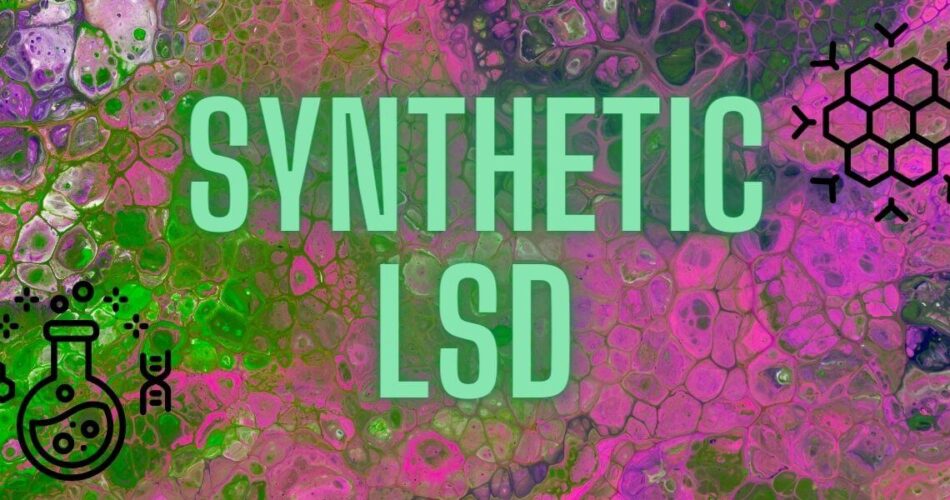Synthetic LSD, such as 25I-NBOMe, is a designer drug that has been gaining popularity in recent years. It’s a synthetic equivalent to lysergic acid diethylamide (LSD), and it’s often referred to as a designer or research chemical because its effects are not fully known. Here’s what you should know about synthetic LSD.
TL;DR
- 25I-NBOMe, also known as N-Bomb or “synthetic LSD,” is a hallucinogenic drug that has become popular in recent years and was created at the University of Berlin in the early 2000s.
- The effects of 25I-NBOMe can last up to 12 hours, which is significantly longer than natural LSD. It’s usually sold as liquid in a blotter paper.
- While there are some reports of people having positive experiences with synthetic LSD use, there are also risks associated with taking it due to its unknown effects and interactions with other drugs.
- Overdosing on synthetic LSD such as NBOMes may lead to rhabdomyolysis or serotonin syndrome; both conditions can be life-threatening if left untreated.
25I-NBOMes (N-Bomb) – New Designer Hallucinogen
25I-NBOMe, also known as N-Bomb or “synthetic LSD,” is a hallucinogenic drug that has become popular in recent years and was created at the University of Berlin in the early 2000s. NBOMe was first developed in a laboratory environment by researchers. The drug is believed to act as an agonist at serotonin receptors, primarily 5-HT2A, and is also thought to affect dopamine and norepinephrine receptors.
The effects of 25I-NBOMe can last up to 12 hours, which is significantly longer than natural LSD. It’s usually sold as liquid in a blotter paper.
The Effects of 25I NBOMe
While there are some reports of people having positive experiences with synthetic LSD use, there are also a number of risks associated with taking it. Because its effects are not fully understood, the risk of overdosing or having an adverse reaction is very real. Keep in mind 25I-NBOMe is not the only N-Bomb you could encounter.
25B-NBOMe, for example, has been known to cause rhabdomyolysis, a condition in which muscle tissue breaks down and releases a protein called myoglobin and electrolytes into the bloodstream. This can lead to organ failure and death. It’s not sure if the same could happen with 25I-NBOMe.
Editor’s Note
Synthetic LSD like 25I-NBOMe can be dangerous and unpredictable. It’s also important to seek medical help immediately if you experience any adverse reactions after taking a designer drug.
If you or someone you know is struggling with addiction, please reach out for help. There are programs available that can provide the necessary support to get back on track.
Synthetic LSD – Risks
Synthetic LSD, such as 25I NBOMe, can be dangerous and life-threatening. It’s not regulated by the FDA or DEA, which means it can be obtained through drug markets. Since synthetic hallucinogens are not regulated, it’s impossible to determine their purity or potency. This increases the risk of an overdose or serotonin syndrome, a potentially life-threatening condition caused by serotonin levels that become too high in the body. Symptoms of serotonin syndrome include agitation, confusion, shivering, and muscle rigidity.
Synthetic drugs, including synthetic LSD like NBOMes, can also have unpredictable interactions with other drugs, so ingesting them with other substances may be very dangerous.

Frequently Asked Questions
Is Synthetic LSD Legal?
No, synthetic LSD is illegal in most countries.
What Are the Short-Term Effects of Synthetic LSD?
The short-term effects of synthetic LSD include increased heart rate and blood pressure, anxiety, paranoia, hallucinations, and seizures.
What Are the Long-Term Effects of Taking Synthetic LSD?
Long-term effects of Synthetic LSD use may include flashbacks, depression, and difficulty concentrating. It can also lead to an increased risk of developing mental health problems such as schizophrenia.
Similar Posts:
- Can LSD Cause Serotonin Syndrome Like Antidepressants?
- Lexapro and LSD: Psychedelics and SSRIs Antidepressants
- Prozac and LSD: Is Mixing Antidepressants and Psychedelics Safe?
- Antidepressants and LSD: Taking Psychedelics and SSRI Meds
- LSD and SSRI | Is It Safe to Take Psychedelics With SSRIs?
- Molly vs LSD: Comparison of the Effects of LSD and MDMA
- Mescaline vs. LSD – Let’s Compare These Popular Hallucinogens




